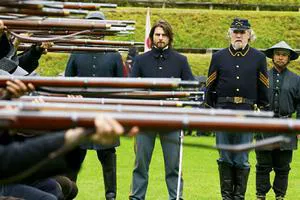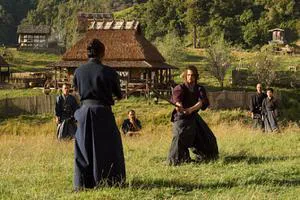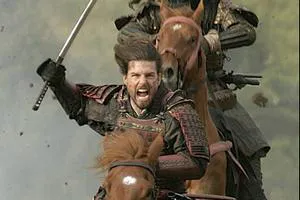The Last Samurai: A Critical Look
I watched it – didn’t throw up – smiled – left – and completely forgot about it. Despite its four Oscar nominations, Edward Zwick’s “The Last Samurai,” with a budget of $100 million, almost entirely fits this algorithm. The idea of yet another Hollywood Japanization this year is understandable. Almost all of America has belonged to the Japanese for several years now. They don’t advertise it, but every American knows it now. So, they are trying to figure out how such a historical injustice happened.

“The Last Samurai” features a purely fairytale scheme with a binary opposition: “the Japanese have roots/the Americans have Winchesters.” Despite the seemingly rigid connection to the Meiji Restoration of 1876-77 – to the restoration of the real-life Emperor Mutsuhito, who defeated the Tokugawa shoguns by attracting imported military equipment (German, by the way, not American) to transition from feudalism to capitalism – this is another Hollywood John Barleycorn, who went beyond the three seas. But the interesting part begins only when he finally gets into the forest beyond those three seas. The backstory is essentially irrelevant to the real plot – with the Winchester show in the USA, the dinner with Prince Omura and Colonel Bagley, and then the audience with the Emperor. The backstory only gives some personal weight to Tom Cruise’s Captain Algren. Like, don’t look at this ugly, small, and big-nosed guy; he has a soul that hurts, a contempt for death, and a wild thirst for life. This is how Americans subtly maintain their self-esteem: the scene where he tears open his shirt – “No, you shoot me, you shoot, Jap” – is impressive, but only in passing.

Katsumoto Takes Center Stage
The plot actually begins when Katsumoto (Ken Watanabe) enters the frame. This is indirectly confirmed by the fact that he was nominated for an Oscar only for “Best Supporting Actor.” The Americans understand, haha, that a Japanese man made their movie. Just know while watching that this is Watanabe’s first role (height 188, wife and two children, advanced leukemia) played in English, and that he will never become a Hollywood star. But, one way or another, in the fairytale “The Last Samurai,” the hero is precisely Katsumoto, a Robin Hood, and not John Barleycorn at all, even though Tom Cruise was the main producer. It is Robin Hood who has so many fresh parameters here that the fairytale becomes watchable even for adults. The samurai was not ashamed that he was mangling English. He silently endured when Algren lay down in front of him, leg over leg. He turned a blind eye when Algren courted his sister, having initially killed her husband. He didn’t chop him down when he had to escape from prison. He believed his beloved son that it was time for him to die. He stood to the death before Omura’s army, anticipating in advance that everything would go his way. Thanks to Bushido, Katsumoto’s reaction at any given moment is adequate to such a number of external impulses that he is incredibly smart, regardless of the fairytale, true story, or hint.

Tom Cruise’s Self-Deprecation
Tom Cruise only reaches the state of “on par” through self-deprecation. It seems that this is purely the merit of the screenwriter. John Logan, most likely, as he knows how to do (“Gladiator,” “The Aviator,” “Sinbad: Legend of the Seven Seas”), preemptively bet on replacing cheap self-esteem with real self-deprecation. Only morons guffawed when Cruise was dressed in the armor of her late husband by Katsumoto’s sister, Taka (Koyuki): “Well, screw her, well, screw her.” The rest were getting into this kind of sex, and laughed a little later when Cruise appeared in armor on the porch, and a little earlier when he first put on the hakama. The laughter here is from an obvious elephant in a china shop who is not ashamed to be an elephant. The laughter during the viewing, by the way, was often in clearly unintended moments. But Logan foresaw that all of Cruise’s adventures were only to highlight the samurai luxury, so that even the little elephant would understand that the past is the future when it is pure. Cruise-Algren clearly highlights this because he himself is aware of his screen mission.

Flaws in Execution
Unfortunately, the desire to endow the fairytale with an epic aura exposed a very mediocre direction in “The Last Samurai.” It is worse than its predecessor, “The Twilight Samurai,” and worse than its successor, “Kill Bill.” This cannot be ignored, since it is connected to them. And if “Kill Bill” is indirect confirmation of Japan’s priority over America, then “The Twilight Samurai” is a direct prequel, no less than the Winchester show. The same Japanese actor Hiroyuki Sanada, who went there to fight for the Tokugawa clan and died in the war, has only changed his name here. He is now not Seibei, but Ujo, Katsumoto’s right hand, but he will die in the same way. However, at the very first comparison with “The Twilight Samurai” (which, by the way, was also nominated for an Oscar – for “Best Foreign Language Film”), it is clear that Edward Zwick (“Legends of the Fall”) does not feel the material. In his equestrian marches at the beginning, there is a high horizon, the frame is cut off above the heads. He didn’t rewatch Hokusai. His foggy sky near Fujiyama is an empty cutaway, like “time passed.” He didn’t read Sei Shonagon. Zwick doesn’t measure up to the level of Watanabe, John Logan, or even Tom Cruise, which is especially noticeable in the wild swings of intelligence and stupidity in the finale. You’ll see.

The Climax: A Battle of Ideologies
Nevertheless, he took his due, and a number of regularly successful scenes during the narrative are worthily crowned by the main battle. First, such a game of toy soldiers, when “erste Kolonne marschiert, zweite Kolonne marschiert,” some with bows and swords, others with rifles and cannons, is elementary difficult to separate on the battlefield so as not to forget anything and everything works according to the idea of “you lie, you won’t kill.” Secondly, the adventures of this idea, when Omura’s army first burned down, and then brought out machine guns, and then – it is clear what – they are very psychologically accurate and complete. That is, the battle itself is a separate movie, a large, colorful metaphor for a rather complex psychological situation, in what conditions a victory is possible at all and what it consists of.
In addition, “The Last Samurai” has a number of successful witticisms, and the Englishman Timothy Spall traditionally played his episode elegantly.